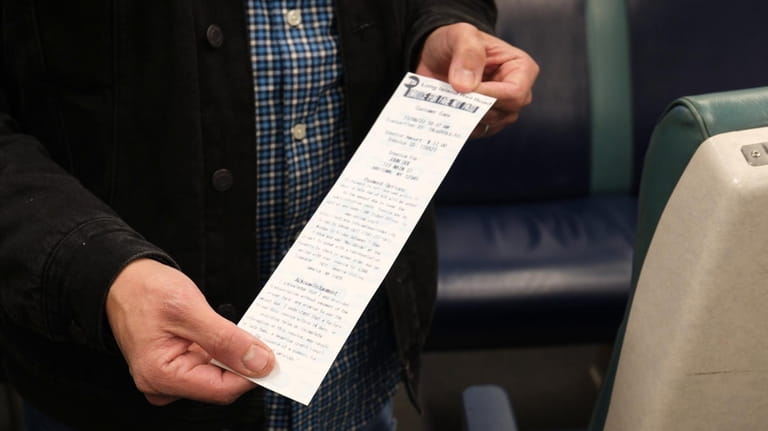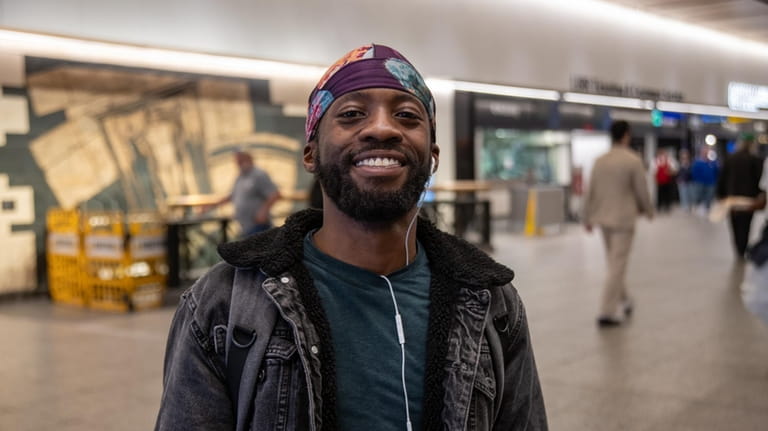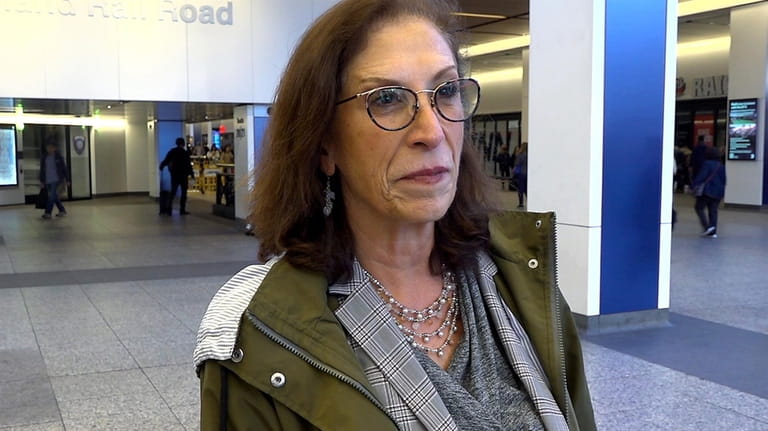LIRR's top fare evaders owe thousands, skip on paying for 100-plus rides — in just 6 months

Some Long Island Rail Road riders have been issued IOU invoices for unpaid train tickets more than 100 times within just six months and owe thousands of dollars for those trips, according to the MTA's list of fare beaters obtained by Newsday.
As the LIRR's list of “repeat offenders” grows, so too has the number of invoices issued to passengers who say they can't pay for their rides — up 60% last year, from about 100,000 in 2022 to nearly 160,000 in 2023, according to MTA figures.
The LIRR’s most persistent evader, according to the data, received 155 invoices as of September, totaling $2,154 in unpaid tickets — the most owed by any person on the list. MTA officials said the list reflects six months of data, which means the individual skipped out on 155 fares in about 180 days.
Even though Metropolitan Transportation Authority officials have acknowledged that sending scofflaws home with bills that most never pay doesn’t work, the system remains in place — recently augmented with increased police enforcement.
A package of new laws just passed by the State Legislature will also help address fare evasion on the LIRR, officials said, including by increasing penalties for repeat offenders and directing revenue from fines back to the railroad.
The 10 passengers who have skipped out on the most fares received 1,119 separate bills, totaling $17,108, according to MTA data. The top 10 fare beaters each have been issued between 87 and 155 invoices, and owe between $1,277 and $2,154.
Gerard Bringmann, chairman of the LIRR Commuter Council, an advocacy group, said he long had known about the list, which the railroad began compiling in 2014, but called it “shocking” that some riders had “actually cracked 100" unpaid invoices.
“It’s not fare evasion. … That’s transit shoplifting,” said Bringmann, who also sits on the MTA Board as a nonvoting rider representative. “I would love, personally, to see some of these people get arrested.”
The list of the LIRR’s most frequent fare evaders reveals the ineffectiveness of the railroad’s system of dealing with a rider who can’t, or refuses, to buy a ticket. Under MTA policy, such a passenger is issued an “invoice for fare not paid,” also known as an “ADL 6009" form, and directed to mail payment to the railroad.
In November, Newsday reported the LIRR in 2022 had written more than 100,000 invoices worth nearly $1.4 million to passengers who said they could not pay for their tickets. That climbed to 159,691 invoices in 2023, worth $2,137,877.
The LIRR has said it only recovers around 5% of the unpaid fares owed.
Passengers with multiple outstanding invoices are placed on an “ineligible list” maintained by the MTA. LIRR conductors, who keep the lists with them on digital devices, are instructed to notify MTA Police if they encounter a passenger who doesn’t pay a fare and is on the list.
As of September, the “ADL 6009 — Ineligible List,” obtained by Newsday through a public records request, was 105 pages. Although it contained more than 6,300 names of “repeat offenders,” many appear to be duplicates, with variations in spellings. Passengers are not required to provide ID when they are issued the invoices, and sometimes give conductors different names when issued multiple invoices, MTA and union officials have said. Because of that uncertainty, Newsday is not publishing the names on the list.
MTA spokesperson David Steckel said, despite receiving inconsistent information, transit officials make an effort to match unpaid-for trips to individual riders, including by trying to verify names and addresses, and observing travel patterns.
Even accounting for apparent duplicates, at least 33 individuals have accrued 50 or more unpaid invoices, totaling $36,878, according to a Newsday analysis of the data.
Baldwin commuter Denzel Francis said he understands that “sometimes, people left their wallet” and legitimately can’t pay for their LIRR ride. But, Francis said, watching fellow passengers repeatedly game the system makes paying riders “furious.”
“If I’m paying, why do they not have to pay?” Francis, 32, asked while waiting for his train at Penn Station.
According to a 2019 audit from State Comptroller Thomas DiNapoli, “the LIRR uses its invoice database to compile a list of the top 800 individuals who have requested seven or more invoices with a total value of over $100.” However, the list provided to Newsday included riders with as few as five invoices, and total values as small as $21.
Amid intensifying scrutiny of its finances, the MTA has ramped up its efforts to address fare and toll evasion, which it says costs the transit agency about $700 million a year, including subway turnstile jumping and faked and obscured license plates. Since late last year, LIRR conductors at Penn Station have been checking tickets on some trains before passengers board. The pilot program initially targeted only trains after Madison Square Garden events, but has been extended to trains at other times too.
MTA Police has deployed more officers onto LIRR trains that frequently have fare disputes while instituting a policy of having police resolve fare disputes at a station platform. Under the previous system, cops intervening in a fare dispute could make the call to let a passenger complete their trip, MTA Police Chief John Mueller told the MTA Board in February. But they learned from conductors that system “didn't really work well.”
“Now you have a person who they tried to get a fare from, they didn't pay the fare, and we allowed them to remain there. It's not a safe situation,” Mueller said when talking about the new fare dispute procedures. “We can still exercise discretion on the platform. It doesn't mean that somebody is definitely going to see enforcement of a summons or an arrest. But it is no longer on the train.”
Asked about how the new policing strategy has impacted fare-beating recidivism on the LIRR, MTA chairman and CEO Janno Lieber told Newsday that it has “not remedied” the problem, but is acting as a deterrent.
“When a conductor comes across a fare evader, they can have a cop intervene, because there's a cop on the train,” Lieber said following the February meeting. “What they're doing, for the first time, I think, in a long time, is they're taking them off the train. So that is probably a significant discouragement for people, irrespective of what process follows.”
Anthony Simon, who heads the union representing LIRR conductors, said that while the steps taken have been an improvement, there remain holes for opportunistic fare beaters to exploit. Because much of the fare beating takes place between New York City stations — and cops can't ride every train — offenders often can complete their trip before a cop boards a train to intervene.
“Our organization has conveyed to the LIRR for the past several years that the current policy of billing riders is just enabling bad behavior,” said Simon, adding that his union’s top priority is protecting train crews from continued harassment and assaults.
In March of last year, a rider who refused to pay his fare assaulted two conductors with a ticket-issuing machine he swiped from one of them, according to police. In December, a conductor was pepper-sprayed on a Queens station platform by a passenger following a fare dispute, police said.
“We need a way to protect our train crews from the continued harassment and assaults they have been enduring,” said Simon, who noted that, while many passengers look to conductors to address fare evasion, LIRR employees “are not cops.”
MTA officials said the stepped-up police enforcement efforts have already made a big difference. The number of summonses issued for fare nonpayment on the LIRR more than doubled from 321 in 2022 to 698 last year. In the first quarter of 2024, MTA Police have already issued 513 summonses to LIRR riders, according to MTA figures.
Fare beating arrests on the LIRR are also up substantially, from 55 in 2022 to 194 in 2023, with 101 more through March of this year.
However, fines collected go to the local jurisdictions that adjudicate the summonses, and not to the railroads.
Lisa Daglian, executive director of the MTA's Permanent Citizens Advisory Committee, who was part of a panel of experts who made recommendations to the MTA on how to address fare evasion, said a package of law amendments just adopted by lawmakers as part of the state budget process will help address repeat fare beaters. Among them: a measure that would move railroad fare evasion summonses from local courts to an “adjudication bureau” at the MTA that would better track repeat offenders, and allow the LIRR to keep the revenue collected from fines.
Other new measures would increase the top fine for repeat fare evasion offenses from $100 to $150. New provisions would also forgive fines for some low-income riders eligible for discounted fare programs, and for offenders who “satisfactorily perform unpaid services” on the LIRR, including cleaning trains.
Those and other measures would allow the MTA to improve fare collection without abruptly pulling the plug on the IOU system, and potentially escalating already-volatile fare disputes, she said.
“It didn't happen overnight that it evolved into this bad system. So it's not going to happen overnight that it evolves into a good system,” Daglian said. “But there are steps that can be taken.”
Seaford commuter William DeVito said that while he believes fare beating remains a major problem in the New York City subway system, he doesn't see it often while commuting and from work on the LIRR. If the LIRR wants to address the problem of lost fare revenue, DeVito said it should do a better job of collecting fares from ticket-holding passengers.
A report on fare evasion published by the MTA last May estimated that a third of all LIRR fares are either uncollected or collected incorrectly, costing the railroad about $24 million annually.
“The biggest problem with the railroad losing money is when a conductor doesn't take tickets,” said DeVito, 27, who routinely observes a conductor not collecting fares because a train is too crowded to walk through. “So, it's not his fault. But it happens all the time.”
Some Long Island Rail Road riders have been issued IOU invoices for unpaid train tickets more than 100 times within just six months and owe thousands of dollars for those trips, according to the MTA's list of fare beaters obtained by Newsday.
As the LIRR's list of “repeat offenders” grows, so too has the number of invoices issued to passengers who say they can't pay for their rides — up 60% last year, from about 100,000 in 2022 to nearly 160,000 in 2023, according to MTA figures.
The LIRR’s most persistent evader, according to the data, received 155 invoices as of September, totaling $2,154 in unpaid tickets — the most owed by any person on the list. MTA officials said the list reflects six months of data, which means the individual skipped out on 155 fares in about 180 days.
Even though Metropolitan Transportation Authority officials have acknowledged that sending scofflaws home with bills that most never pay doesn’t work, the system remains in place — recently augmented with increased police enforcement.
WHAT TO KNOW
A list of repeat offending LIRR fare beaters shows that some riders have been billed for more than 100 unpaid train tickets and owe thousands of dollars for those rides in a six month time period. The LIRR's most persistent fare evader has been issued 155 IOU invoices, and owes $2,154 in unpaid tickets.
The number of “ADL-6009" invoices issued by the LIRR to passengers who say they can't pay for a ticket rose 60% last year, from around 100,000 in 2022 to around 160,000 in 2023. The LIRR has said it recovers only around 5% of the unpaid fares owed.
- The MTA has said it has taken measures to address the problem, including by stepping up police enforcement, resulting in fare evasion arrests and summonses more than doubling from 2022 to 2023.
A package of new laws just passed by the State Legislature will also help address fare evasion on the LIRR, officials said, including by increasing penalties for repeat offenders and directing revenue from fines back to the railroad.
The 10 passengers who have skipped out on the most fares received 1,119 separate bills, totaling $17,108, according to MTA data. The top 10 fare beaters each have been issued between 87 and 155 invoices, and owe between $1,277 and $2,154.
Gerard Bringmann, chairman of the LIRR Commuter Council, an advocacy group, said he long had known about the list, which the railroad began compiling in 2014, but called it “shocking” that some riders had “actually cracked 100" unpaid invoices.
“It’s not fare evasion. … That’s transit shoplifting,” said Bringmann, who also sits on the MTA Board as a nonvoting rider representative. “I would love, personally, to see some of these people get arrested.”
Nearly 160,000 invoices in 2023
The list of the LIRR’s most frequent fare evaders reveals the ineffectiveness of the railroad’s system of dealing with a rider who can’t, or refuses, to buy a ticket. Under MTA policy, such a passenger is issued an “invoice for fare not paid,” also known as an “ADL 6009" form, and directed to mail payment to the railroad.

An example of an "invoice for fare not paid." Credit: Craig Ruttle
In November, Newsday reported the LIRR in 2022 had written more than 100,000 invoices worth nearly $1.4 million to passengers who said they could not pay for their tickets. That climbed to 159,691 invoices in 2023, worth $2,137,877.
The LIRR has said it only recovers around 5% of the unpaid fares owed.
Passengers with multiple outstanding invoices are placed on an “ineligible list” maintained by the MTA. LIRR conductors, who keep the lists with them on digital devices, are instructed to notify MTA Police if they encounter a passenger who doesn’t pay a fare and is on the list.
As of September, the “ADL 6009 — Ineligible List,” obtained by Newsday through a public records request, was 105 pages. Although it contained more than 6,300 names of “repeat offenders,” many appear to be duplicates, with variations in spellings. Passengers are not required to provide ID when they are issued the invoices, and sometimes give conductors different names when issued multiple invoices, MTA and union officials have said. Because of that uncertainty, Newsday is not publishing the names on the list.
MTA spokesperson David Steckel said, despite receiving inconsistent information, transit officials make an effort to match unpaid-for trips to individual riders, including by trying to verify names and addresses, and observing travel patterns.
Even accounting for apparent duplicates, at least 33 individuals have accrued 50 or more unpaid invoices, totaling $36,878, according to a Newsday analysis of the data.
Baldwin commuter Denzel Francis said he understands that “sometimes, people left their wallet” and legitimately can’t pay for their LIRR ride. But, Francis said, watching fellow passengers repeatedly game the system makes paying riders “furious.”
“If I’m paying, why do they not have to pay?” Francis, 32, asked while waiting for his train at Penn Station.

Baldwin commuter Denzel Francis, 32, says watching fellow passengers repeatedly game the system makes paying riders furious. Credit: Ed Quinn
According to a 2019 audit from State Comptroller Thomas DiNapoli, “the LIRR uses its invoice database to compile a list of the top 800 individuals who have requested seven or more invoices with a total value of over $100.” However, the list provided to Newsday included riders with as few as five invoices, and total values as small as $21.
Fare, toll evasion cost $700M annually
Amid intensifying scrutiny of its finances, the MTA has ramped up its efforts to address fare and toll evasion, which it says costs the transit agency about $700 million a year, including subway turnstile jumping and faked and obscured license plates. Since late last year, LIRR conductors at Penn Station have been checking tickets on some trains before passengers board. The pilot program initially targeted only trains after Madison Square Garden events, but has been extended to trains at other times too.

Credit: Newsday/Steve Pfost
MTA Police has deployed more officers onto LIRR trains that frequently have fare disputes while instituting a policy of having police resolve fare disputes at a station platform. Under the previous system, cops intervening in a fare dispute could make the call to let a passenger complete their trip, MTA Police Chief John Mueller told the MTA Board in February. But they learned from conductors that system “didn't really work well.”
“Now you have a person who they tried to get a fare from, they didn't pay the fare, and we allowed them to remain there. It's not a safe situation,” Mueller said when talking about the new fare dispute procedures. “We can still exercise discretion on the platform. It doesn't mean that somebody is definitely going to see enforcement of a summons or an arrest. But it is no longer on the train.”
Asked about how the new policing strategy has impacted fare-beating recidivism on the LIRR, MTA chairman and CEO Janno Lieber told Newsday that it has “not remedied” the problem, but is acting as a deterrent.
“When a conductor comes across a fare evader, they can have a cop intervene, because there's a cop on the train,” Lieber said following the February meeting. “What they're doing, for the first time, I think, in a long time, is they're taking them off the train. So that is probably a significant discouragement for people, irrespective of what process follows.”
Union: policy 'enabling bad behavior'
Anthony Simon, who heads the union representing LIRR conductors, said that while the steps taken have been an improvement, there remain holes for opportunistic fare beaters to exploit. Because much of the fare beating takes place between New York City stations — and cops can't ride every train — offenders often can complete their trip before a cop boards a train to intervene.
“Our organization has conveyed to the LIRR for the past several years that the current policy of billing riders is just enabling bad behavior,” said Simon, adding that his union’s top priority is protecting train crews from continued harassment and assaults.
In March of last year, a rider who refused to pay his fare assaulted two conductors with a ticket-issuing machine he swiped from one of them, according to police. In December, a conductor was pepper-sprayed on a Queens station platform by a passenger following a fare dispute, police said.
“We need a way to protect our train crews from the continued harassment and assaults they have been enduring,” said Simon, who noted that, while many passengers look to conductors to address fare evasion, LIRR employees “are not cops.”
Summonses more than doubled
MTA officials said the stepped-up police enforcement efforts have already made a big difference. The number of summonses issued for fare nonpayment on the LIRR more than doubled from 321 in 2022 to 698 last year. In the first quarter of 2024, MTA Police have already issued 513 summonses to LIRR riders, according to MTA figures.
Fare beating arrests on the LIRR are also up substantially, from 55 in 2022 to 194 in 2023, with 101 more through March of this year.
However, fines collected go to the local jurisdictions that adjudicate the summonses, and not to the railroads.
Lisa Daglian, executive director of the MTA's Permanent Citizens Advisory Committee, who was part of a panel of experts who made recommendations to the MTA on how to address fare evasion, said a package of law amendments just adopted by lawmakers as part of the state budget process will help address repeat fare beaters. Among them: a measure that would move railroad fare evasion summonses from local courts to an “adjudication bureau” at the MTA that would better track repeat offenders, and allow the LIRR to keep the revenue collected from fines.

Lisa Daglian, MTA Permanent Citizens Advisory Committee Executive Director. Credit: Ed Quinn
Other new measures would increase the top fine for repeat fare evasion offenses from $100 to $150. New provisions would also forgive fines for some low-income riders eligible for discounted fare programs, and for offenders who “satisfactorily perform unpaid services” on the LIRR, including cleaning trains.
Those and other measures would allow the MTA to improve fare collection without abruptly pulling the plug on the IOU system, and potentially escalating already-volatile fare disputes, she said.
“It didn't happen overnight that it evolved into this bad system. So it's not going to happen overnight that it evolves into a good system,” Daglian said. “But there are steps that can be taken.”
Seaford commuter William DeVito said that while he believes fare beating remains a major problem in the New York City subway system, he doesn't see it often while commuting and from work on the LIRR. If the LIRR wants to address the problem of lost fare revenue, DeVito said it should do a better job of collecting fares from ticket-holding passengers.
A report on fare evasion published by the MTA last May estimated that a third of all LIRR fares are either uncollected or collected incorrectly, costing the railroad about $24 million annually.
“The biggest problem with the railroad losing money is when a conductor doesn't take tickets,” said DeVito, 27, who routinely observes a conductor not collecting fares because a train is too crowded to walk through. “So, it's not his fault. But it happens all the time.”
SBU protests continue ... Farmingdale housing development ... Knicks advance .. FeedMe: Croissant Cookies
SBU protests continue ... Farmingdale housing development ... Knicks advance .. FeedMe: Croissant Cookies

